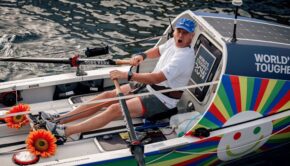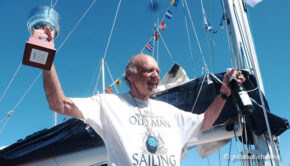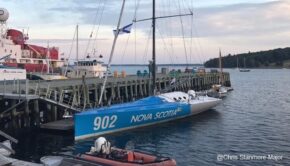Parallel destinies around the world
Published on April 11th, 2023
The inaugural Global Solo Challenge 2023-24 seeks to be a budget-friendly solo, non-stop race around the world. For boats from 32 to 55 feet with an IRC rating below 1.370, a pursuit start over 11 weeks begins in A Coruña, Spain, with the first boat to return deemed the winner. In this report by Margherita Pelaschier, her search of history brought together two iconic adventurers:
When I found out about the Global Solo Challenge (GSC) and its innovative format that favors the use of existing boats and no specific class, I went in search of the designs of the vessels used by the pioneers of single-handed sailing around the globe. In my “sea library” I found Sir Francis Chichester’s “Gipsy Moth Circles the World”.
In 1967, Chichester was the first to circumnavigate the globe solo via the three great capes, stopping only once; it took him nine months and one day. While looking for the third annex to the Italian edition in which he detailed the Gipsy Moth IV’s sail plan, I stumbled upon a chapter written by his wife Sheila Chichester. So often, beside every great man there’s a great woman.
Sheila Chichester’s story made me think of the similarities between two great seafarers who each wrote a chapter of sailing history: Francis Drake and Francis Chichester.
To cope with the separation from her husband during his solo sailing adventure, Sheila, a strong believer in positive thinking and prayer, had little cards printed out with the prayer attributed to Drake and gave them to friends and family. The prayer is an invitation not only to the explorers of the unknown but to us all, it’s an exhortation to challenge our limits and “push back the horizons of our hopes”.
But who were Sir Francis Drake and Sir Francis Chichester and what did they have in common?
“Sic parvis, magna – Great things from small beginnings”
Firstly, they shared the same first name, Francis, they were both born in England, had a humble background, and travelled since a very young age.
Drake was born around 1540 into a family of farmers. The eldest of twelve children, at thirteen he boarded a cargo ship and just nine years later became the captain of a ship in the North Sea. His reputation of “Dragon” of the sea, as suggested by his surname, spread quickly after the attack on Cadiz and his incursions in South America and the Caribbean. Drake made the Latin motto “sic parvis, magna” his own, emphasising the fact that despite his humble origins he felt destined for greatness.
Chichester was born in 1901 into the humble family of a Church of England clergyman. Due to his parents’ modest means, he spent his entire childhood at boarding school. When he finished his studies at the end of the First World War he emigrated to New Zealand in search of fortune. Having qualified as a pilot he set up a prosperous business.
But the situation in world at the time didn’t help him and the Great Depression forced him to return home. In England he took delivery of a plane with which he intended to fly to New Zealand and that was when his passion for breaking records and solo crossings began. He received various awards and inspired by navigation techniques he patented innovative solutions to establish flight position.
Francis Drake’s journey around the world
Francis Drake is famous for being the first Englishman to sail around the world (with crew and stopping). Following his success against the Spanish fleet, Queen Elisabeth I recruited Drake and his Sea Dogs. By issuing “letters of marque”, the Queen authorised these corsairs to attack and raid the vessels of Philip II of Spain and take the spoils back to England. In 1577, the Queen sent Drake to raid the coasts of South America in the Pacific Ocean, which was controlled by the Spanish.
A fleet of four ships left Plymouth but after crossing the Strait of Magellan, Drake continued the journey with only his flagship, the Golden Hind. He sailed north up the coast of South America, but details of this journey are sparse because on his return the Queen ordered that all diaries be kept secret and imposed silence, or death, on all who had been on board. Apparently, after sacking Valparaiso, he headed north in search of the famous Northwest passage but didn’t find it.
Sailing south, he found safe harbour in the north of California in order to prepare his ship and claimed sovereignty of the area for Queen Elizabeth I, naming it New Albion. Sailing south west, he reached the Maluku Islands, in the Malaysian archipelago, and loaded his ship with precious spices such as cloves, nutmeg, and macis, used to preserve food and for medical and cosmetic purposes. Sailing away towards South Africa, Drake stopped a few times on his way back to London where he arrived three years after he’d left, in September 1580.
Francis Chichester’s journey around the world
Almost four centuries later, Francis Chichester’s journey around the world was much quicker and straightforward. It was an era in which navigation was no longer only about trade but had become a proper sport, especially for English and French yachtsmen.
After his passion for flying, Chichester funnelled his competitive spirit into sailing. In 1960, he won the first OSTAR, the single-handed Trans-Atlantic race he organized. In 1964, he took part in it again and came second, but he wanted to go further. For an aviator and navigator horizons are never far enough.
Almost 65, on 27 August 1966, Chichester sailed from Plymouth on board his 16-metre ketch, Gypsy Moth IV, towards the unknown. He completed the first single-handed circumnavigation via the three great capes (Good Hope, Leeuwin and Horn) stopping only once, in Sydney. Back in the UK, after nine months and one day at sea, he received a hero’s welcome.
Two queens, two great sailors
In 1581, on his return from the journey around the world, Queen Elisabeth I awarded Francis Drake a knighthood and appointed him mayor of Plymouth.
Four centuries later, in 1967, by an extraordinary coincidence, Queen Elisabeth II knighted Francis Chichester using the sword used by her predecessor Queen Elizabeth I to knight Francis Drake.
The spirit of adventure
The similarities between the lives of these two men are truly unique, but I think the most relevant is the trigger that induced them – each in their own era and with different means – to dare, to go beyond the known boundaries and their own limits, driven by the spirit of adventure and the desire to discover the unknown.
I here present the prayer credited to Sir Francis Drake (1577), dedicated to sailors and to all dreamers:
Disturb us, Lord,
when we are too well pleased with ourselves,
when our dreams have come true because we have dreamed too little,
when we arrived safely because we sailed too close to the shore.
Disturb us, Lord,
when with the abundance of things we possess, we have lost our thirst for the waters of life;
having fallen in love with life, we have ceased to dream of eternity and in our efforts to build a new earth, we have allowed our vision of the new heaven to dim.
Disturb us, Lord,
to dare more boldly, to venture on wider seas where storms will show your mastery; where losing sight of land, we shall find the stars.
We ask you to push back the horizons of our hopes
and to push into the future
in strength, courage, hope, and love.
I dedicate Drake’s prayer to all dreamers and to the skippers of the GSC, who will set sail and start their journey around the world starting from August 2023, hoping it will inspire us all to take on the future with “strength, courage, hope, and love”.












 We’ll keep your information safe.
We’ll keep your information safe.